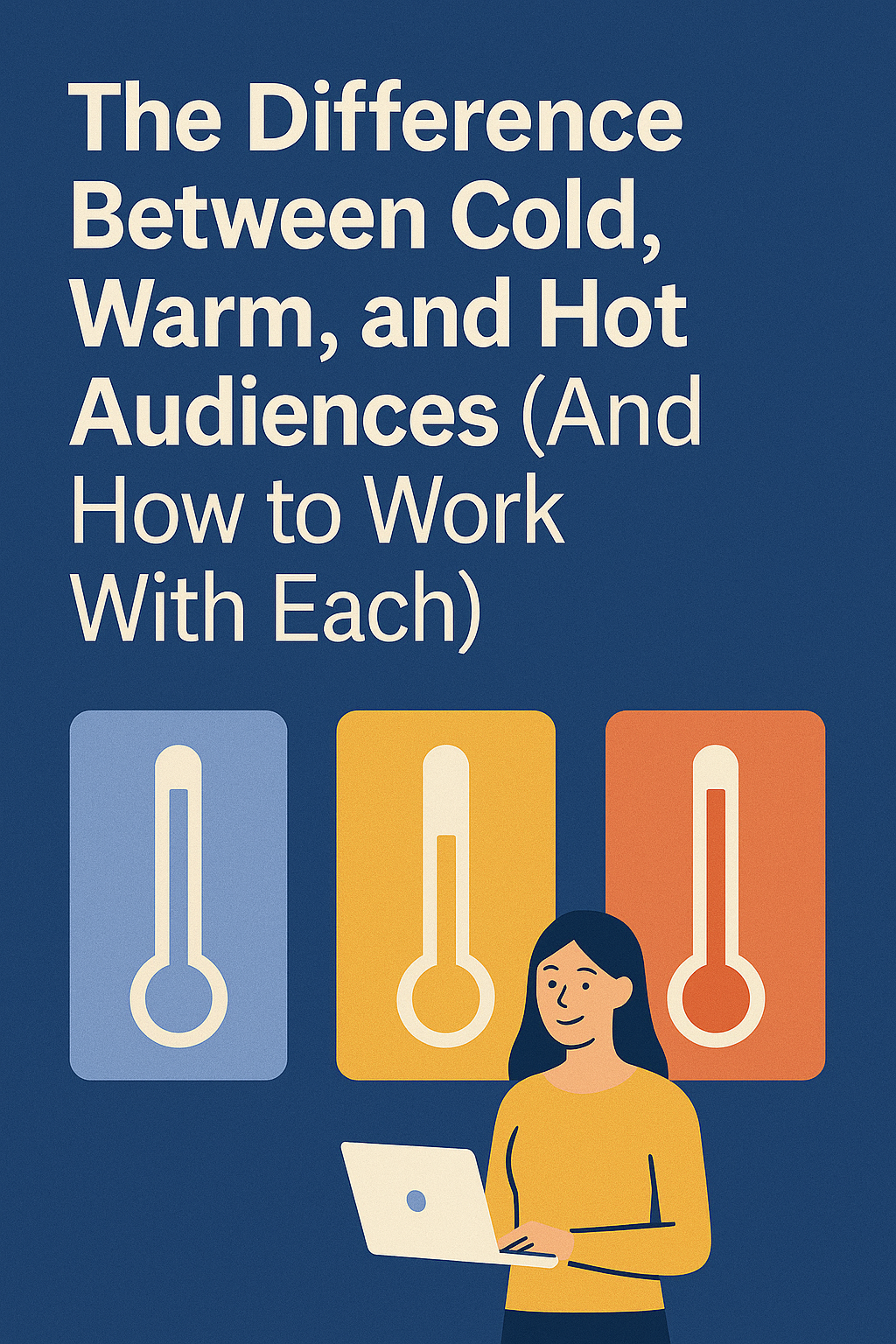Understanding the different types of audiences is one of the most important skills a traffic manager can master. Not every person who sees your ad is at the same stage of the buying journey—and your messaging, offer, and strategy should change accordingly.
In this article, you’ll learn the key differences between cold, warm, and hot audiences, how to identify them, and how to build effective campaigns tailored to each stage.
Why Audience Temperature Matters
Running ads without considering audience temperature is like offering marriage on the first date—it’s too much, too soon.
By identifying whether your audience is cold, warm, or hot, you can:
- Avoid wasting money on poor targeting
- Build trust gradually
- Improve click-through rates (CTR) and conversions
- Reduce ad fatigue and improve ROI
- Scale campaigns with predictability
Let’s break down what each audience type means—and how to work with them strategically.
What Is a Cold Audience?
A cold audience has never interacted with your brand. They don’t know who you are, what you sell, or why they should care.
This is the widest part of the funnel (TOFU – Top of Funnel). Your goal is awareness and first contact.
Characteristics:
- No brand recognition
- No previous website visits
- No email subscription or social engagement
- Likely unaware of the problem you solve
Best campaign objectives:
- Video views
- Reach
- Engagement
- Traffic (with a nurturing funnel)
- Lead magnet download (low friction)
Messaging tips:
- Focus on education and curiosity
- Use scroll-stopping creative
- Avoid hard selling—this is about building interest
- Address pain points they might not know they have
Example ad:
“Struggling to grow your small business on Instagram? Here are 5 mistakes to avoid.”
Targeting options:
- Interest-based audiences
- Lookalikes (based on quality sources like customers or leads)
- Broad targeting (with strong creatives and copy)
Goal:
Spark curiosity and get them into your ecosystem (email list, page visit, video view).
What Is a Warm Audience?
A warm audience knows who you are. They’ve interacted with your content, visited your website, watched a video, or signed up for a lead magnet—but haven’t bought anything yet.
This is the middle of the funnel (MOFU). Your job is to build trust, demonstrate value, and deepen the relationship.
Characteristics:
- Engaged with social media
- Watched part of your video
- Visited a landing page
- Opened emails
- Signed up for a freebie but didn’t buy
Best campaign objectives:
- Lead generation
- Conversion (low-ticket offers)
- Add to cart
- Messenger or WhatsApp engagement
- Retargeting campaigns
Messaging tips:
- Offer proof (testimonials, stats, case studies)
- Overcome objections
- Share results, transformations, or detailed benefits
- Invite them to take the next step (e.g., join webinar, try free demo)
Example ad:
“Over 1,000 business owners used our ad framework to double their leads. Download it free.”
Targeting options:
- Custom audiences (website visitors, video viewers, IG engagers)
- Email list retargeting
- Lead magnet retargeting
Goal:
Move the prospect from interest to consideration and intent.
What Is a Hot Audience?
A hot audience is ready to buy. They’ve shown clear buying signals—like checking pricing pages, starting checkout, or engaging with multiple high-intent actions.
This is the bottom of the funnel (BOFU). Your role is to help them decide and close the deal.
Characteristics:
- Added items to cart
- Viewed pricing or order page
- Attended a sales webinar
- Replied to sales messages
- Engaged with multiple offers
Best campaign objectives:
- Conversions (sales, checkout)
- Catalog sales (e-commerce)
- Limited-time promos
- Scarcity-based offers
- Testimonial-based retargeting
Messaging tips:
- Use urgency and scarcity
- Provide bonuses, discounts, or guarantees
- Address final objections directly
- Push them to act now
Example ad:
“Only 12 hours left! Enroll now and get 2 bonus coaching calls.”
Targeting options:
- Custom audience: checkout page visitors
- Abandoned cart
- Email list segment: sales page openers
- High-intent video viewers or PDF downloaders
Goal:
Convert. Push the user across the finish line.
How to Segment Audiences in Practice
On Meta (Facebook/Instagram), you can build custom audiences based on:
- Video views (25%, 50%, 75%)
- Website visits (specific pages or durations)
- Instagram or Facebook page engagement
- Form completions (e.g., leads who didn’t buy)
- Email list uploads
- Add to cart but no purchase
On Google Ads, use:
- Remarketing lists from GA4
- YouTube viewer engagement
- Custom intent audiences
- Abandoned cart sequences (eCommerce)
On TikTok Ads, use:
- Video viewers
- Profile visits
- Website clicks or conversions
Proper segmentation allows you to run tailored ads for each level of temperature.
Why Mixing Up Temperatures Hurts Performance
If you show a “Buy Now” ad to a cold audience, you’ll likely get low CTRs and high CPCs.
If you keep showing awareness ads to a hot audience, you’ll lose urgency and conversions.
Misaligned ads = poor results, even if your product is amazing.
That’s why the best traffic managers map their ad creatives to audience temperature—every time.
Tips to Warm Up Cold Traffic Efficiently
- Start with a valuable video (1–2 minutes)
- Retarget video viewers with a free resource
- Then move to retargeting based on lead magnet download
- Finally, push sales or conversions to people who went through the sequence
This way, you’re creating a self-liquidating funnel that pays for itself and gets better with time.
Final Thoughts: Traffic Management Is Relationship Management
In the end, managing traffic is about managing relationships. Cold, warm, and hot audiences aren’t just labels—they reflect the user’s emotional journey with your brand.
Great traffic managers understand this and adjust:
- Their message
- Their creative
- Their offers
- Their frequency
- Their budgets
…based on where the user is in the funnel.
If you master audience temperatures, you’ll be able to turn cold strangers into raving buyers—on any platform.

